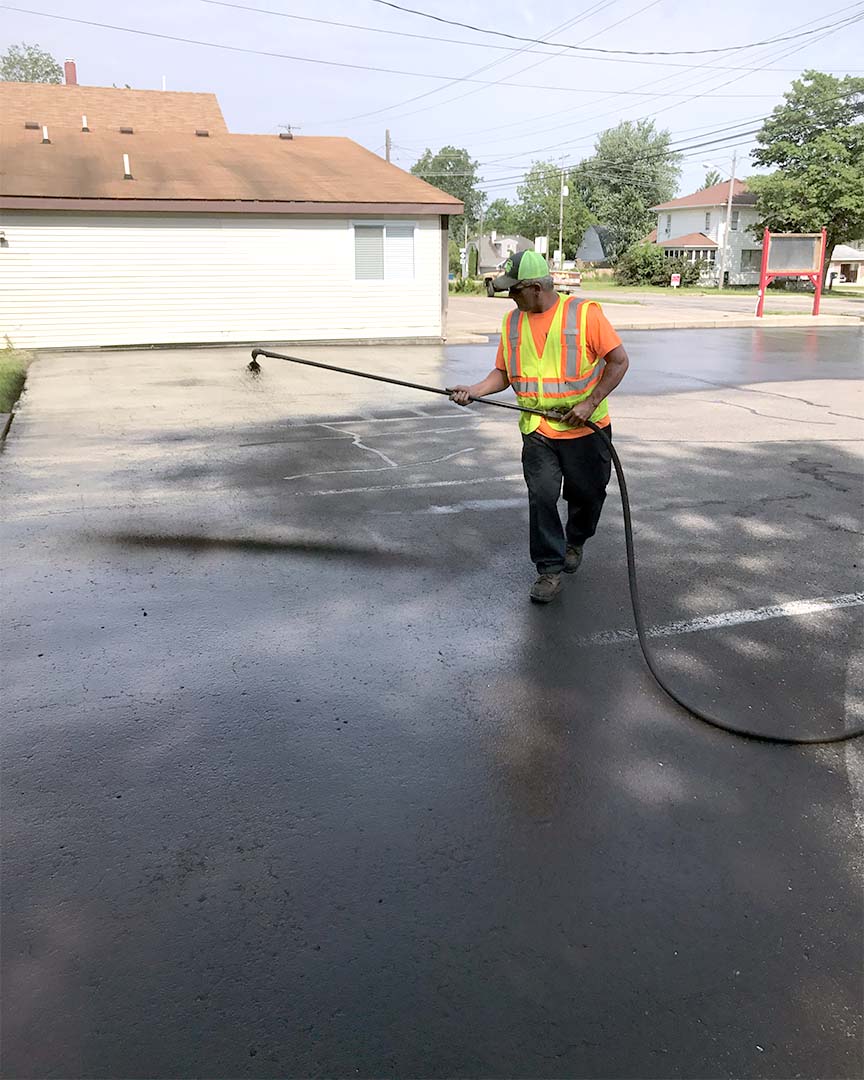Discover the Power of Commercial Parking Area Leading and Asphalt Sealing
Discover the Power of Commercial Parking Area Leading and Asphalt Sealing
Blog Article
Hot Mix Asphalt: A Lasting Service for Sidewalk
Hot Mix Asphalt (HMA) has actually emerged as a leading lasting selection for sidewalk services, offering a myriad of innovative modern technologies and environmental advantages. As the demand for environment-friendly construction techniques grows, discovering the subtleties of HMA's sustainability can offer useful understandings into the future of sidewalk services.
Ecological Benefits of Warm Mix Asphalt

Furthermore, Warm Mix Asphalt helps to alleviate urban warmth island effects. Its dark shade takes in sunshine, minimizing the quantity of warm mirrored back into the environment compared to lighter-colored sidewalks. This can reduce ambient temperature levels in city locations, reducing the need for cooling and ultimately decreasing power consumption.
Additionally, Warm Mix Asphalt adds to boosted stormwater management. Its porous nature enables water to reenergize and penetrate the pavement groundwater products, minimizing runoff and the risk of flooding. These environmental benefits make Hot Mix Asphalt a sustainable selection for leading roadways and freeways.
Energy Effectiveness in HMA Manufacturing
Is power performance a crucial element in the production of Warm Mix Asphalt (HMA)? Definitely. Power plays a significant role in the production of HMA, impacting both cost and environmental sustainability. One essential aspect of power efficiency in HMA production is using warm mix asphalt (WMA) technologies (angled parking). WMA permits the blending and placement of asphalt at reduced temperature levels compared to typical warm mix asphalt, resulting in reduced energy intake throughout production. This process not only decreases gas use yet also reduces greenhouse gas emissions, making it a more eco-friendly choice.
In addition, developments in plant modern technologies have led to even more energy-efficient HMA production processes. By maximizing energy use in HMA manufacturing, the sector can lower its carbon footprint while preserving top quality sidewalk products.
Recyclability of Hot Mix Asphalt
The recyclability of Warm Mix Asphalt (HMA) is a pivotal element of its sustainability and lasting environmental effect. HMA is among the most recycled materials in the United States, with over 100 million tons of recovered asphalt sidewalk (RAP) being reused annually in new pavement building. Reusing HMA supplies numerous ecological benefits, such as minimizing the requirement for virgin products, lowering energy usage throughout manufacturing, and decreasing the amount of waste sent to land fills.
The process of recycling HMA entails crushing the existing sidewalk, squashing it right into smaller sized pieces, and mixing it with new accumulation and asphalt binder to develop a recycled mix. On the whole, the recyclability of HMA plays a substantial function in promoting lasting methods within the pavement industry.

Long-Term Performance of HMA
Asphalt pavements show durability and resilience over a prolonged duration, reflecting the long-lasting performance of Hot Mix Asphalt (HMA) The durability of HMA important link can be credited to its capability to withstand rush hour tons, extreme climate problems, and the impacts of aging. Researches have actually revealed that properly designed and effectively created HMA sidewalks can last for 20 years or more with regular maintenance. The trick to making the most of the long-term efficiency of HMA hinges on making use of premium products, adhering to ideal techniques in building and construction, and applying reliable upkeep strategies. Proper water drainage, regular assessments, and timely repairs are crucial for maintaining the architectural stability of HMA pavements with time. In addition, advancements in HMA technology, such as making use of advice polymer-modified binders and cozy mix asphalt, have further boosted the toughness and long life of HMA sidewalks. By prioritizing top quality building and maintenance techniques, HMA remains to confirm itself as a cost-effective and lasting remedy for resilient sidewalk facilities.

HMA: Resilience and Sustainability
Showing both longevity and sustainability, Hot Mix Asphalt (HMA) has actually become a cornerstone in the building and construction of lasting pavement facilities - commercial parking lot paving. HMA's toughness originates from its ability to withstand hefty loads, harsh weather, and high website traffic volumes, have a peek here making it a reliable selection for roads, freeways, and airport runways. The make-up of HMA, which normally includes aggregates, binder, and filler, plays an important role in improving its longevity and resistance to tear and put on
Furthermore, HMA's sustainability exists in its recyclability and energy-efficient production procedure. The ability to recycle redeemed asphalt pavement (RAP) in new HMA blends reduces the need for virgin materials and reduces the ecological influence of pavement building and upkeep. Furthermore, the power efficiency of creating HMA hinges on its reduced blending temperatures contrasted to various other sidewalk materials, resulting in minimized power intake and greenhouse gas discharges.
Verdict
In verdict, hot mix asphalt (HMA) provides a sustainable remedy for sidewalk with its ecologically pleasant qualities. HMA's recyclability, energy performance in manufacturing, and long-lasting resilience make it an environmentally friendly choice for road building.
HMA is one of the most recycled materials in the United States, with over 100 million loads of reclaimed asphalt sidewalk (RAP) being recycled every year in new sidewalk building.The procedure of reusing HMA involves milling the existing sidewalk, crushing it into smaller sized pieces, and blending it with new accumulation and asphalt binder to produce a recycled mix.Asphalt pavements demonstrate longevity and durability over an extended duration, reflecting the lasting efficiency of Warm Mix Asphalt (HMA) Furthermore, advancements in HMA modern technology, such as the use of polymer-modified binders and cozy mix asphalt, have actually even more boosted the sturdiness and longevity of HMA pavements. The capacity to reuse reclaimed asphalt sidewalk (RAP) in new HMA combinations decreases the need for virgin products and reduces the environmental effect of pavement building and upkeep.
Report this page